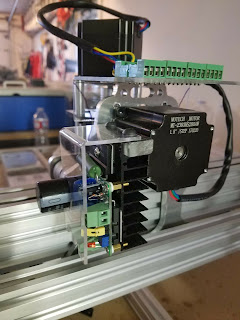A Simpler Spoil Board?
SPOIL BOARD
Google'ing shows that there are a gaggle of spoil board configurations out there. Since my initial build I have been using a spoil board made of particle board with routed T-slots.
I used a secondary T-slot board to increase the holding options.
The upper spoil board was also made from particle board with T-slots milled transversely.
Practical Work Holding
I mostly have been working routing wood and that has driven me to use a different work holding method. The following approach will not work for milling metals at least not anything robust.
Tape as a Work Holding Medium
After many frustrations hitting the clamps used in traditional work holding ) using a variety or T-clamps) I investigated using tape as a hold-down medium. It worked really well for everything I was doing.
The type of tape mattered and after testing many types I ended up with this:
This tape holds and releases very well and all of my recent projects have used this approach to work holding.
 |
| https://photos.app.goo.gl/QrKkmm1w7f2V9V1R7 |
Current Work Holding..
I have been using a flat piece of 1/4" MDF held on top of the particle board spoil board. Then the working material was taped to that.... didn't make sense!
 |
| https://photos.app.goo.gl/7iDMXiQnjktoYn8N7 |
- The particle board was not flat and although I could mill it flat the multiple piece nature of the design was going to be problematic.
- The seam where the multi-peices meet was not reliably flat!
- The stack of spoil boards was unnecessary and was eating up Z space.
- Part of the reason for a multi-peice spoil board was that the bed size was larger than a 1/2 sheet and I did not want to buy a full sheet and use only part of it. Turns out that the machine cannot reach the full extend of the bed DOH! The spoil board does not need to cover the entire bed.
Why not get rid of everything and move to a single flat spoil board the size of the cutting area and use tape as the holding medium. I found that the tape held the small pieces well and the larger the piece the more holding power.
Alternate Spoil Board & Work Holding
So I decided to move to a single piece spoil board using the following materials:
- 1/2 partial sheet of 1/2 MDF purchased from Lowes. Cut to length. Got this from the sheet goods pre-cut section. I think it was 24"x 48"
- Hillman M5-.8 x 16 mm button head screws
- Drop In M5 T Nut Slot
 |
| The layout |
 |
| The hardware is set about 1/2 way into the material |
 |
| A depth setting jig for setting the stop on the drill press |
 |
| Assemble the screw and nut before you place it over the bed |
 |
| Spoil board installed |
Installation
- Make a drilling jig
- Using a drill press [hole needs to be drilled straight] drill holes using the jig to setup the drill press stop.
- Assemble the screw nut pairs before placing the board on the bed
- Place the board on the bed aligned to the beds extrusion.
- Jiggle the screw from the top causing the nuts to fall in the extrusions groove.
- Test each fastener to insure its nut has turned and grabbed the rail by pulling up on the board.
- Then loosen the screw to its extent without coming out of the nut and repeat for all fasteners.
- Tighten all screws.
Improvements
I imagine that I could mount a T-track one each side in the area the spindle cannot reach enabling traditional hold-down for large materials. I could bolt the T-track on each edge using a long piece of 1/4 aluminum bolted to the underside of the spoil board as the base for the T-track to bolt to.
Don






Comments
Post a Comment